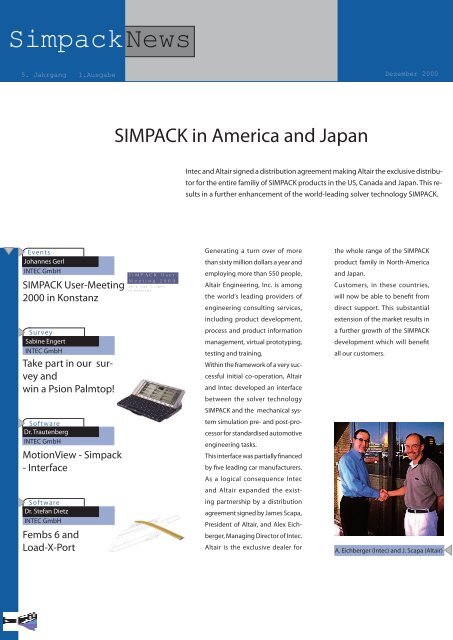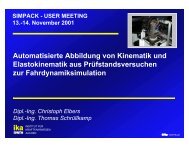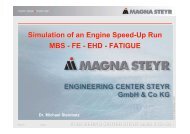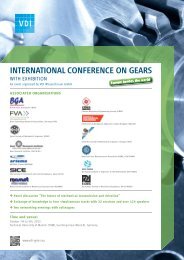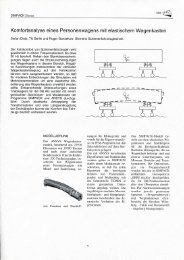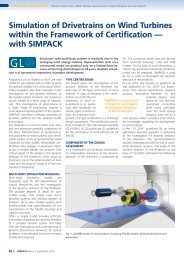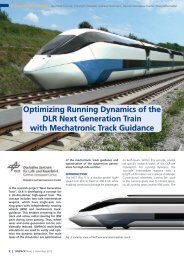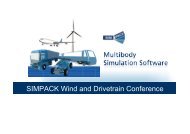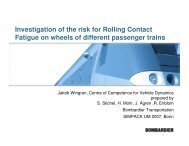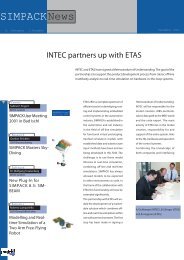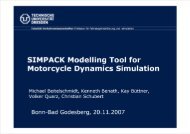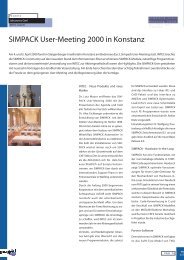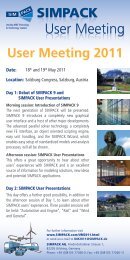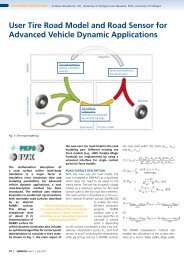SimpackNews
SimpackNews
SimpackNews
You also want an ePaper? Increase the reach of your titles
YUMPU automatically turns print PDFs into web optimized ePapers that Google loves.
<strong>SimpackNews</strong><br />
5. Jahrgang 1.Ausgabe<br />
Events<br />
Johannes Gerl<br />
INTEC GmbH<br />
SIMPACK User-Meeting<br />
2000 in Konstanz<br />
Survey<br />
Sabine Engert<br />
INTEC GmbH<br />
Take part in our survey<br />
and<br />
win a Psion Palmtop!<br />
Software<br />
Dr. Trautenberg<br />
INTEC GmbH<br />
MotionView - Simpack<br />
- Interface<br />
Software<br />
Dr. Stefan Dietz<br />
INTEC GmbH<br />
Fembs 6 and<br />
Load-X-Port<br />
SIMPACK in America and Japan<br />
Intec and Altair signed a distribution agreement making Altair the exclusive distributor<br />
for the entire familiy of SIMPACK products in the US, Canada and Japan. This results<br />
in a further enhancement of the world-leading solver technology SIMPACK.<br />
Generating a turn over of more<br />
than sixty million dollars a year and<br />
employing more than 550 people,<br />
Altair Engineering, Inc. is among<br />
the world‘s lea ding providers of<br />
engineering con sulting services,<br />
including pro duct development,<br />
process and product information<br />
management, virtual prototyping,<br />
tes ting and training.<br />
Within the framework of a very successful<br />
initial co-operation, Altair<br />
and Intec developed an interface<br />
between the solver technology<br />
SIMPACK and the mechanical system<br />
simulation pre- and post-processor<br />
for standardised auto motive<br />
engi neering tasks.<br />
This inter face was partially financed<br />
by five leading car manufacturers.<br />
As a logical consequence Intec<br />
and Altair ex panded the existing<br />
partnership by a distribution<br />
agree ment signed by James Scapa,<br />
President of Altair, and Alex Eich-<br />
berger, Managing Director of Intec.<br />
Altair is the exclusive dealer for<br />
Dezember 2000<br />
the whole range of the SIMPACK<br />
pro duct family in North-America<br />
and Japan.<br />
Customers, in these countries,<br />
will now be able to benefit from<br />
direct support. This sub stantial<br />
extension of the mar ket re sults in<br />
a further growth of the SIMPACK<br />
development which will benefit<br />
all our customers.<br />
A. Eichberger (Intec) and J. Scapa (Altair)
Events<br />
Johannes Gerl<br />
INTEC GmbH<br />
SIMPACK User-Meeting 2000 in Konstanz<br />
Am 4. und 5. April 2000 fand im Steigenberger-Inselhotel in Konstanz am Bodensee das 3. Simpack User-Meeting statt. INTEC brachte<br />
die SIMPACK-Community auf den neuesten Stand der Informationen: Eben erschienene SIMPACK-Module, zukünftige Programmversionen<br />
und die bevorstehende Umwandlung von INTEC zur Aktiengesellschaft waren die Highlights. Die SIMPACK-User gestalteten<br />
mit neunzehn Vorträgen den Großteil der Veranstaltung. Am Ende herrschten bei den über achtzig Teilnehmern zwei Eindrücke vor:<br />
die Freude an dem gelungenen User-Meeting und die Begeisterung über die Vorträge.<br />
INTEC - Neue Produkte und neue<br />
Märkte<br />
Dr. Lutz Mauer eröffnete das SIM-<br />
PACK User-Meeting 2000 mit der<br />
Präsentation der Agenda und hieß<br />
alle Teilnehmer herzlich willkommen.<br />
Dr. Alex Eichberger präsentierte die<br />
Entwicklung von SIMPACK seit dem<br />
letzten User-Meeting im Herbst 1998.<br />
Die letzten beiden Jahre sei es gelungen,<br />
neben dem Ausbau von SIMPACK<br />
Wheel/Rail, SIMPACK Automotive + in<br />
der Automobilindustrie zu etablieren.<br />
Die Zahl der Installationen von SIM-<br />
PACK wächst immer noch um 50%<br />
stärker als der Gesamtmarkt auf dem<br />
CAE-Sektor. Dies ist umso erstaunlicher<br />
als die Aktivitäten sich bis dato fast<br />
ausschließlich auf Europa konzentrierten,<br />
wo SIMPACK-User durch ein<br />
internationales Support-Team in der<br />
Firmenzentrale in Weßling unterstützt<br />
werden.<br />
Durch die Anfang 2000 begonnene<br />
Kooperation mit dem amerikanischen<br />
Softwarehaus ALTAIR steht SIMPACK<br />
nunmehr auch der amerikanische<br />
und japanische Markt offen. Um dem<br />
Wachstum der Firma Rechnung zu tragen<br />
und um für weitere Entwicklungssprünge<br />
von SIMPACK die Grundlage<br />
zu schaffen, wird INTEC sich im kommenden<br />
Jahr in eine Aktiengesellschaft<br />
umwandeln.<br />
Vertriebs- und Marketingleiter Johannes<br />
Gerl gab eine Übersicht von den<br />
neuen Programmodulen, die zuletzt<br />
für SIMPACK entwickelt wurden. Diese<br />
sind das Interface zu I-deas (FE- und<br />
CAD-Paket) und das Interface zu<br />
AMESim und SIMPACK Optimisation.<br />
Load-X-Port, eine neue Schnittstelle<br />
zum Export von Lasten aus SIMPACK<br />
nach FE-Programmen wurde vom<br />
verantwortlichen Entwickler Dr. Stefan<br />
Dietz vorgestellt.<br />
Entwicklungsleiter Dr. Wolfgang Trautenberg<br />
schließlich kündigte die neue<br />
SIMPACK Zwischenversion 8.5 an und<br />
gab einen Ausblick auf die neue Major<br />
Release 9.0.<br />
SIMPACK - Hardware-in-the-Loop<br />
SIMPACK hat eine Funk tiona li tät, mit<br />
der man beliebige Modelle in FORT-<br />
RAN-Code exportieren kann. Hierdurch<br />
zeigt SIMPACK optimale Voraussetzungen<br />
für einen Code-Generator für<br />
den Mech anikteil von Hardware-inthe-Loop-Simulationen.<br />
Herr Neubeck<br />
vom FKFS gab in seinem Vortrag einen<br />
umfassenden Überblick der Potentiale,<br />
welche in diesem Bereich in SIMPACK<br />
stecken: beispielsweise die automatische<br />
Code-Konvertierung in C und<br />
der Anschluß von SIMPACK-Modellen<br />
an den MATLAB Realtime Workshop,<br />
welcher beim FKFS bereits mehrfach<br />
in Projekten für die Industrie durchgeführt<br />
wurde.<br />
Partner-Software<br />
Demnächst neu in SIMPACK verfügbar<br />
ist das Swift-Tyre Model von TNO.<br />
Page 2<br />
New<br />
1/20
ws<br />
000<br />
Swift benutzt zur Abbildung der Reib-<br />
eigenschaften denselben Ansatz wie<br />
MF-Tyre, also die Magic Formula nach<br />
Prof. Pajeka. Die höherfrequente Reifendynamik<br />
wird allerdings durch ein<br />
Ringmodell abgebildet, welches über<br />
diskrete Federn und Dämpfer mit der<br />
Nabe verbunden ist.<br />
ALTAIR, neuer Distributionspartner<br />
für SIMPACK in den USA und in Japan,<br />
stellte das Interface MotionView<br />
- Simpack vor, welches den ALTAIReigenen<br />
Pre- und Post-Processor für<br />
Au tomotive-Mehrkörpermodelle an<br />
SIMPACK anbindet.<br />
Kontakt, Kometen und Skispringer<br />
Der späte Nachmittag des ersten Tages<br />
brachte einen ebenso unterhaltsamen<br />
wie seitens der verwendeten Simulationstechnologie<br />
beeindruckenden<br />
Ausklang. Dr. Hilchenbach vom Max-<br />
Planck-Institut für Aero nomie zeigte<br />
SIMPACK-Mo del le des Kometen-Landers<br />
Rosetta, welcher in zwanzig Jahren<br />
auf dem Kometen Wirtanen landen<br />
soll. Herr Lehner von der TU-München<br />
zeigte Bio-Mechanik-Modelle, welche<br />
zur Ver besserung von Skistiefeln und<br />
Skibindungen für konventionelle und<br />
für Curving-Skier verwendet wurden.<br />
Volker Quarz von der Technischen<br />
Universität Dresden lieferte einen<br />
Überblick über die Kontaktmodelle in<br />
SIMPACK, eingesetzt beispielsweise bei<br />
der Simulation einer keilge sicherten<br />
Rohrladung bei Kurvenfahrt.<br />
SIMPACK Wheel/Rail<br />
Die Kundenvorträge zu SIMPACK<br />
Wheel/Rail zeigten die gesamte Bandbreite<br />
eines ausgereiften und leistungsstarken<br />
Produkts, das die Marktführerschaft<br />
beansprucht.<br />
Christoph Weidemann von der Bochumer<br />
Verein Verkehrstechnik GmbH ging<br />
die Simulation gummigefederter Eisenbahnräder<br />
an. Diese Simulation ordnet<br />
sich in den Forschungsbereich ein, läßt<br />
Page 3<br />
sich aber dennoch ohne Neupro grammier<br />
un gen mit dem serienmäßigen<br />
Simpack Rad-Schiene-Kontaktmodell<br />
durchführen.<br />
Pier Wiersma von NS Technisch Onderzoek<br />
zeigte Simulationen, welche<br />
begleitend zu Messungen an einer<br />
Weiche durchgeführt wurden und sich<br />
als „sehr nützlich zum Verständnis der<br />
Meßergebnisse“ erwiesen. Vor allem<br />
die Planung weiterer Messungen ließ<br />
sich durch den Einsatz der Simulation<br />
effektiv gestalten.<br />
Im Zentrum des Vortrages von Michael<br />
Seibert von der Siemens Duewag Schienenfahrzeuge<br />
GmbH stand ein Fahrwerk<br />
nach dem Halbdrehgestellprinzip,<br />
also ein Drehgestell, dessen zwei<br />
Rahmen für bessere Bogengängigkeit<br />
gelenkig miteinander verbunden sind.<br />
Er verglich das Halbdrehgestellfahrwerk<br />
mit einem konventionellen und<br />
einem Ein zel rad-Doppelfahrwerk. Die<br />
Simu lations ergebnisse stellten Verschleiß,<br />
Stabilität und Fahrkomfort der<br />
einzelnen Konzepte gegenüber.<br />
Karl Tillmetz und Dr. Bernd Kessler von<br />
Adtranz (CH) AG zogen schließlich<br />
alle Register eines modernen Simulationstools<br />
mit einem ausgereiften<br />
Wheel/Rail-Plugin. Durch den Import<br />
von FE-Modellen von Wagenkästen<br />
in SIMPACK wurde bereits bei einer<br />
Reihe von Fahrzeugen der Fahrkomfort<br />
deutlich verbessert. Diese Simulationen<br />
zusammen mit Know-How und<br />
Erfahrung in der Meßtechnik sind der<br />
entscheidende Schritt zum Digitalen<br />
Proto typen im Schienenfahrzeugbau,<br />
der ein enormes Potential im Bereich<br />
Kostensenkung bietet.<br />
Download der Vorträge vom SIMPACK User-Meeting 2000 :<br />
http://www.simpack.de/html/infodesk/UM2000/user_meeting.html
SIMPACK Automotive +<br />
SIMPACK Automotive + ist während der<br />
letzten beiden Jahre mit inzwischen<br />
über fünfzig Installationen zu einem<br />
Standard-Werkzeug in der Automobilindustrie<br />
geworden. Entsprechend<br />
waren zum ersten Mal die Vorträge aus<br />
dem Automobilbereich in der Überzahl<br />
- viele davon mit Berichten über ausgesprochene<br />
High-End-Anwendungen.<br />
Den Auftakt machte Prof. Kovanda, von<br />
der Czech Technical University Prag. Ein<br />
konzeptioneller Vergleich zwischen<br />
den Fahrwerken eines Porsche Carrera<br />
und eines Honda Accord Coupé wurde<br />
an der TU Prag im Rahmen einer Studienarbeit<br />
durchgeführt, jeweils mit<br />
Gesamtfahrzeugmodellen mit elastokinematischen<br />
Achsfüh rungen.<br />
Heinz Weinfurter vom Ingenieurbüro<br />
Dr. Hirschberg, Steyr, simulierte mit<br />
SIMPACK Automotive + Extremfahrmanöver<br />
von Sattelzügen der Firma MAN<br />
Nutzfahrzeuge. Die detaillierten Modelle<br />
von Zugmaschine und Auf iegern,<br />
unter anderem mit tor sions elastischem<br />
Rahmen, brachten auch bei Fahrmanö-<br />
vern nahe an der Kipp grenze eine bril-<br />
liante Übereinstimmung von Versuch<br />
und Simulation.<br />
Bei der MAN Nutzfahrzeuge AG wird<br />
SIMPACK Automotive + für zahlreiche<br />
Komponenten bishin zu Gesamtfahrzeugsimulationen<br />
mit elastischen, FEmodellierten<br />
Rahmen und Achskomponenten<br />
eingesetzt. Thomas Ille zeigte<br />
Teilmodelle von Antriebssträngen,<br />
Motoren mit Lagern, Aufhängungen<br />
und dem neuen Produkt Trucknology<br />
Generation bei Prüf stands ve rsuchen.<br />
Imre Boros von der DaimlerChrysler<br />
AG demonstrierte den Einsatz von<br />
SIMPACK in der Nutzfahrzeugbranche<br />
des Konzerns an Beispielen. Hier zeigte<br />
er die Lösung spezieller Problemstellungen<br />
wie Taumelschwingungen des<br />
Motorblocks, des Getriebeblocks und<br />
der Lenkungspendel mittels Simpack.<br />
Weiter sprach er von der Einbindung<br />
von SIMPACK in die Prozeßkette bei<br />
der Fahrzeugent wicklung, wie z.B. bei<br />
der Entwicklung von Fahr dynamikre ge-<br />
lungs syste men (ESP), der Wendekreisbe-<br />
rech nung und der Lastkollektivermitt-<br />
lung für FE-Berech nungen.<br />
Lauri Ohra-Aho zeigte die SIMPACK-Ak-<br />
tivitäten bei der Ford AG. Angefangen<br />
mit den ersten Lizenzen von SIMPACK<br />
1997 wird SIMPACK Automotive + heute<br />
für Gesamtfahrzeugsimulationen, zum<br />
Teil mit elastischem Karosseriekörper,<br />
und als Verbund des SIMPACK Solvers<br />
mit ALTAIR’s Mo tionView zur Analyse<br />
von Radaufhängungen eingesetzt.<br />
Das nächste Usermeeting wird im No-<br />
vember 2001 stattfinden. Wir würden<br />
uns freuen, wenn Sie daran teilnehmen<br />
würden.<br />
Page 4<br />
Ne<br />
1/2
ws<br />
000<br />
Page 5<br />
Dr. Lutz Mauer: Eröffnung<br />
Dr. Alex Eichberger: Neue Märkte<br />
Johannes Gerl: Neue Produkte<br />
Dr. Stefan Dietz: Fembs 6<br />
Dr. Wolfgang Trautenberg:<br />
SIMPACK 8.5 und 9<br />
Das Auditorium<br />
Thomas Ille, MAN Nutzfahrzeuge<br />
Dr. Bernd Kessler, ADtranz Schweiz<br />
Imre Boros, DaimlerChrysler Nutzfahrzeuge<br />
Pier Wiersma, NS Technisch Onderzoek
1<br />
2<br />
3<br />
Survey<br />
Sabne Sabine Engert<br />
INTEC GmbH<br />
Create the Future of CAE<br />
Win a Psion 5mx Pro with Leather Case<br />
DLR, developer of the SIMPACK basic methods, is creating the future of computer aided engineering. Many new methods,<br />
algorithms and software solutions will be developed during the coming years. With this survey we would like to have your<br />
opinion about the future of our business. Return the questionnaire by 15th february 2001 and you could win a Psion S 5mx<br />
pro. This Psion Palmtop has the power to communicate via e-mail, internet, fax or SMS with your colleages and friends, to<br />
organize your business and private agenda, or to connect with your desktop PC.<br />
How long have you already been working with simulation tools?<br />
less than<br />
a year<br />
1 - 3<br />
years<br />
To what extent do you use the functionality of the following systems?<br />
MBS FEA CAD<br />
How satisfied are you with those tools?<br />
MBS FEA CAD<br />
4 - 5<br />
years<br />
Your Simulation Environment<br />
Computer Aided<br />
Control Engineering<br />
(CACE)<br />
Computer Aided<br />
Control Engineering<br />
(CACE)<br />
more than<br />
5 years<br />
Hardware<br />
in the Loop<br />
(HIL)<br />
Hardware<br />
in the Loop<br />
(HIL)<br />
Non User<br />
up to 25% of its capabilities<br />
up to 50% of its capabilities<br />
up to 75% of its capabilities<br />
use its full capabilities<br />
Going regularly over<br />
the systems capabilities<br />
very satisfied<br />
satisfied<br />
less than satisfied<br />
not at all satisfied<br />
don`t know<br />
Page 6<br />
New<br />
NewN<br />
1/20<br />
1/20
s<br />
ews<br />
00<br />
00s<br />
4<br />
5<br />
6<br />
7<br />
8<br />
9<br />
Page 7<br />
As you know there can be specific problems with simulation packages. What is the major problem with the simulation<br />
package that you currently use? (several answers possible)<br />
It requires<br />
too much<br />
time<br />
the functionality<br />
is not<br />
sufficient<br />
it is too specialised<br />
There is no<br />
problem<br />
Which kind of product integration (two in one) would you be interested in?<br />
Often two different modelling tools are used. You may have to enter the same modelling data twice, once in each modelling<br />
package. How much data has to be entered twice? (Please answer in %)<br />
% MBS+CAD % FEA+CAD % MBS+CACE % MBS+FEA<br />
The Future<br />
Imagine your simulation tools in ten years.<br />
Will it be necessary to know more or less engineering theory than today for using your tool?<br />
I guess more I guess less I don`t know<br />
Integrating Your Tools<br />
other, it is __________________<br />
___________________________<br />
MBS+CAD FEA+CAD MBS+CACE MBS+FEA other, it is __________________<br />
If you received 50 000 Euro to improve the facilities available at your work, would you invest them in ...<br />
(Please fill in your order of preference 1 - 4: 1=being most important, 4=being less important)<br />
a different<br />
software<br />
In ten years there will be ...<br />
...one general CAEtool<br />
that consists of<br />
all the others<br />
a develop ment<br />
project to improve<br />
your tool<br />
...the same tools as<br />
today, but with much<br />
better interfaces<br />
software<br />
training for<br />
yourself<br />
...more specialised<br />
tools with more sophisticated<br />
interfaces<br />
theoretical<br />
training for<br />
yourself<br />
...don`t know
10<br />
11<br />
12<br />
13<br />
14<br />
Concerning the functionality of a CAE-tool my simulation tool should ...<br />
be easier to<br />
handle<br />
Concerning the handling of a CAE-tool I prefer to have...<br />
‘one button’<br />
solutions<br />
If there were to be other products from the SIMPACK team, I would be interested in<br />
Fluid Simulation (Hydraulics,<br />
Pneumatics, etc.)<br />
Hardware-in-the-loop<br />
extension<br />
dispose of<br />
extended<br />
functionality<br />
as much control over the software’s<br />
functionality as possible<br />
Let’s talk about SIMPACK<br />
contain more<br />
powerful solver<br />
technology<br />
CACE Fatigue<br />
Analysis<br />
the SIMPACK-solver as a<br />
plug-in for CAD systems<br />
Extended FEA-connection<br />
(Co-Simulation, non-linear FEA,<br />
integrated FEA-tool etc.)<br />
If we need further information concerning CAE or especially SIMPACK, could we call you by telephone?<br />
name function<br />
company e-mail-address<br />
don`t know<br />
Which area of SIMPACK should be concentrated on, in terms of its future development?<br />
Usability Technology Libraries<br />
Other, it is _______________________________<br />
Copy and fax by 15th february 2001 to INTEC GmbH +49-8153-9288-11<br />
don`t know other, it is<br />
______________________<br />
Graphical User<br />
Interface<br />
Yes, my telephone number is __________________________ No<br />
other, it is<br />
____________________<br />
don`t know<br />
Page 8<br />
Ne<br />
1/2
ws<br />
000<br />
New Software<br />
Dr. Wolfgang Trautenberg<br />
INTEC GmbH<br />
Interface between SIMPACK and MotionView<br />
ALTAIR and INTEC have presented a Beta-version of the interface between the pre- and post-processor MotionView and the SIMPACK<br />
solver. This project has had the support of Alfa Romeo, BMW, Ford, Porsche and Volkswagen. The current function ality of the interface<br />
allows a MotionView model to be calculated using the SIMPACK time domain solver, as well as allowing plots and animations of the<br />
SIMPACK produced results.<br />
Project Partner<br />
The development of the interface has<br />
been backed by the Automotive Industry,<br />
who have highlighted what they<br />
would like featured in the inter face.<br />
Current MotionView users of the preand<br />
post-processor see the possibility<br />
for their current simu lation capabilities<br />
to be ex tended with the addition of the<br />
fastest and most reliable MBS solver on<br />
the market.<br />
The development of the interface has<br />
taken 3.5 man years. Funding has come<br />
from Alfa Romeo, BMW, Ford, Porsche<br />
and Volkswagen.<br />
MotionView<br />
MotionView is currently used al most<br />
exclusively for building up auto motive<br />
models, whether it be single as semblies<br />
or complete vehicles. With the so-called<br />
Wizards, the models can be built up<br />
in the form of multilevel as semblies<br />
from ready made com ponents such<br />
as suspen sions, steering systems and<br />
power trains. To build up a completely<br />
new model however the model must<br />
be in ASCII format. Models prepared<br />
within MotionView by simulation engineers,<br />
can than be easily mo dified<br />
Page 9<br />
by the relevant vehicle specialists,<br />
within the MotionView en viron ment.<br />
The vehicle specialists do not need to<br />
have a complete under standing of the<br />
pro gram, but only a general overview<br />
of how it operates.<br />
You can use the model browser, alongside<br />
the 3D graphics, for the visualisation<br />
of the model structure, which is not<br />
too dissimilar to the file browser of an<br />
operating system. As in SIMPACK, it is<br />
possible within Mo tionView to display<br />
graphically the results of a simulation<br />
in the form of animations and plots. The<br />
animation is based upon the ALTAIR<br />
H3D file. This pure results file contains<br />
the time history of the simulation and<br />
the 3D description of the model. This<br />
allows the results files to be given to<br />
other users whilst keeping the exact<br />
details of the model set-up secret. This<br />
H3D file is a 3D animation file which is<br />
so compact - you can send it or publish<br />
it easily via internet.<br />
Further details about the interface are<br />
going to be discribed in one of the following<br />
<strong>SimpackNews</strong>.
New Software<br />
Dr. Stefan Dietz<br />
INTEC GmbH<br />
New Tools for MBS-FEA-Interfacing:<br />
FEMBS 6 and Load-X-Port<br />
An efficient and accurate implementation of fexible bodies is one of the major advantages of SIMPACK. With the new Version 6 of<br />
FEMBS and the new interface Load-X-Port, it is now possible to import fexible structures even more conveniently into SIMPACK and<br />
to export the loads, acting on a fexible body, from SIMPACK to FEA-codes. The easy-to-use interface of Load-X-Port provides all the<br />
data necessary for the FEA tools to calculate defections and stresses. This can lead to enormous potential savings in terms of time<br />
and money within the development process.<br />
Flexible Bodies in SIMPACK Using<br />
FEMBS 6<br />
The SIMPACK Interface used to import<br />
flexible bodies, FEMBS, is currently<br />
available as Version 6 for the FEA codes<br />
ABAQUS, ANSYS, I-deas, NASTRAN and<br />
MARC. Here - in contrast to other MBS<br />
tools - SIMPACK can take into consideration<br />
the geometric stiffening effects,<br />
al lowing for the increased bending<br />
stiffness of the rotor blades while rotat-<br />
ing. This method is as accurate as using<br />
a FEA tool but the calculation requires<br />
less computation time and much less<br />
user effort, than if the fexible body was<br />
subdivided into separate fexible bodies<br />
and later merged in a multi-body<br />
system software.<br />
The capabilitiy of the new Version 6 of<br />
FEMBS has now been expanded by a<br />
new feature. In SIMPACK, fexible bodies<br />
are con nected to the multi-body<br />
system by force elements constraints<br />
and a joint. Sometimes these interconnections<br />
cause local deformations at<br />
the attachment points of the structure.<br />
Consider the de formations of a railway<br />
car body which is connected, at distinct<br />
points, to an electrical transformer.<br />
To treat such local deformations, it is<br />
either possible to use so-called static<br />
modes or to use a large number of<br />
normal modes. Generally, the normal<br />
mode approach is less efficient due to<br />
a large number of additional degrees of<br />
freedom corresponding to the normal<br />
modes. The static mode approach is<br />
fre quently difficult to apply, because<br />
it is sometimes impossible to define an<br />
appropriate set of boundary con ditions<br />
for the static mode cal cu lations. This<br />
can be particularly problematic when<br />
looking at foating vehicle com ponents<br />
such as fexible car bodies. In contrast,<br />
FEMBS now uses the frequency re-<br />
sponse mode approach. This applies<br />
to floating vehicle com ponents and<br />
has be come the most appropriate<br />
solution ap proach for fexible bodies<br />
in SIMPACK. The deformed shape of<br />
an elastic part, due to external forces<br />
acting on the body, can now be taken<br />
into con sideration much more easily.<br />
An additional calculation step is all<br />
that is required within FEMBS to yield<br />
the results, which means that it is not<br />
necessary to repeat the FE analysis. The<br />
set of additional frequency re sponse<br />
modes can represent elastic body de-<br />
formation for all parameters (stiffness,<br />
damping, etc.) of the interconnections.<br />
With a single set of modes the user may<br />
perform para meter variations, whilst<br />
obtaining accurate elastic behaviour.<br />
Therefore, the number of models<br />
exchanged between FEA-codes and<br />
Page 10<br />
Ne<br />
1/2
ws<br />
000<br />
SIMPACK is decreased, as well as improving<br />
the handling quality of the<br />
whole design process.<br />
Calculation of Loads on Flexible<br />
Bodies in SIMPACK<br />
Having imported a fexible structure to<br />
SIMPACK, all the forces acting on the<br />
body can be calculated in SIMPACK using<br />
the time integration module.<br />
As a first step, the user of FEMBS has to<br />
select nodes on the FEA–model which<br />
should be transformed to mar kers in<br />
SIMPACK. All these markers are then<br />
available to apply external forces in the<br />
multi-body simulation, i.e. constraint<br />
forces, spring and damper forces etc.<br />
Load-X-Port<br />
After the time integration has been<br />
performed, the forces acting on the<br />
fexible structure are available for any<br />
attachment point and time step. However,<br />
the external forces produced<br />
by the springs, joints, etc. are not necessarily<br />
in equilibrium, i.e. an overall<br />
ac ce leration of the body would appear<br />
in the FEA-code. Therefore Load-X-Port<br />
automatically adds the movement<br />
of the body fixed reference frame calculated<br />
by SIMPACK to the load vector<br />
which is exported. The FEA-code then<br />
calculates and takes into account the<br />
corresponding inertia forces for a<br />
quasi-static overall motion.<br />
Evaluating the result of the time integration,<br />
the user can decide which time<br />
steps should be written to the result file<br />
by Load-X-Port. The files serve as the<br />
input for the quasi-static time domain<br />
calculations in the FEA- codes, giving<br />
the stresses and de fections.<br />
A selection tool helps to quickly define<br />
either the number of time steps with a<br />
certain increment or the time interval<br />
in which to perform the calculations.<br />
Page 11<br />
The result file is stored as an ASCII<br />
file. Currently the user has the choice<br />
between the formats of ANSYS and<br />
NASTRAN. Load-X-Port will be avail a ble<br />
for Life time calculation tools in the<br />
near future.<br />
New BEAM Available Soon<br />
For simple, beam-like sectioned structures<br />
with constant cross sec tional are-<br />
as, for instance stabiliser bars and shafts<br />
of drive trains, the SIMPACK pre-processor<br />
BEAM can provide the same input<br />
for SIMPACK, as a FEA package creates<br />
together with FEMBS. By 2001BEAM<br />
will be able to consider three-dimensional<br />
frameworks. A graphical user<br />
interface directly integrated into SIM-<br />
PACK will also be available.<br />
Benefits<br />
SIMPACK offers the user high-end simulation<br />
technology for the con sideration<br />
of fexible structures. All the additional<br />
features make the handling of common<br />
tasks by simu lation experts much<br />
easier and allow a more integrated<br />
design process.<br />
These abilities are essential for an<br />
accurate and efficient simulation of<br />
fexible parts such as stabilisers, leaf<br />
springs, sub frames, twist beam rear<br />
axle suspension systems and car bodies<br />
in automotive and railway design.
Staff<br />
Dr. Alex Eichberger<br />
INTEC GmbH<br />
Neue Verantwortlichkeiten bei INTEC<br />
Mit Beginn des Jahres 2000 wurden<br />
die SIMPACK-Entwicklungsaufgaben<br />
neu strukturiert. Der Schritt ist<br />
im Erfolg der Software begründet,<br />
in der ständig wachsenden Zahl<br />
von Installationen und Entwicklungsprojekten.<br />
Der SIMPACK-Entwicklungspart ner<br />
DLR konzentriert sich künftig auf<br />
den Bereich der MKS-Methoden,<br />
also Algorithmen, Numerik, Solver<br />
und CAE-Interfacing. Der Einsatz<br />
von SIMPACK für DLR-eigene<br />
Forschungspro jekte in den Berei-<br />
chen Straßen- und Schienenfahr-<br />
zeuge und Flugzeuge bleibt jedoch<br />
erhalten und ist eine unserer anspruchsvollsten<br />
Testplatt for men.<br />
INTEC nimmt sich der eigent li -<br />
chen Software-Entwicklung von<br />
SIMPACK an. In diesem Zuge leitet<br />
Dr. Wolfgang Trauten berg nun die<br />
Entwicklungsabteilung bei INTEC<br />
und Johannes Gerl den Bereich<br />
Vertrieb und Marketing.<br />
Dr. Wolfgang Trautenberg begann<br />
seine mittlerweile zehnjährige Aktivität<br />
im SIMPACK-Umfeld mit der<br />
Entwicklung der CAD-Interfaces<br />
ProSIM und CatSIM und war dann<br />
für das SIMPACK-GUI zuständig.<br />
Nach abgeschlossener Promotion<br />
verbrachte er das letzte Jahr zum<br />
Teil in den USA, um in Zusammenarbeit<br />
mit ALTAIR als INTEC-seitiger<br />
Projektleiter die MotionView-SIM-<br />
PACK-Schnittstelle zu entwickeln<br />
(siehe Artikel in dieser SIMPACK<br />
News). In seinem neuen Job als<br />
Director Product De ve lop ment<br />
führt er nun die Ent wicklung von<br />
SIMPACK und der SIMPACK-Inter-<br />
faces in die Zukunft.<br />
Johannes Gerl arbeitete von 1994<br />
an zunächst ein Jahr beim DLR<br />
und wirkte an der Entwicklung von<br />
SIMPACK Wheel/Rail beim Benchmarking<br />
der neuen Software mit.<br />
Es folgten insgesamt fünf Jahre<br />
bei INTEC. Die ersten zwei Jahre<br />
als Projektingenieur, zunächst im<br />
Bereich Wheel/Rail, dann auch<br />
im Bereich Automotive + . Die folgenden<br />
beiden Jahren bei INTEC<br />
leitete er Engineering-Projekte<br />
und übernahm Aufgaben aus dem<br />
Vertrieb, auch in Zusammenarbeit<br />
mit den SIMPACK-Partnern im Ausland.<br />
Sein Engagement im SIMPACK<br />
Marketing brachte die SIMPACK<br />
News und den „Leo nardo da Vinci-<br />
Stil“ der Corporate Identity von<br />
SIMPACK hervor. Seine neue Stelle<br />
als Director Sales and Marketing<br />
umfaßt den nationalen und internationalen<br />
Vertrieb von SIMPACK,<br />
sowie das SIMPACK-Marketing.<br />
Johannes Gerl und Dr. Wolfgang Trautenberg<br />
Page 12<br />
News New<br />
1/20
1/99 Page 13<br />
s<br />
00<br />
.... News .... News ..... News .... News .... News ..... News .... News ..<br />
IdeSIM available now<br />
The SIMPACK family of CAD inter-<br />
faces has a new member, IdeSIM,<br />
the interface between I-deas and<br />
SIMPACK. IdeSIM is completely<br />
integrated into the I-deas Graphic<br />
User Interface (GUI) and enables the<br />
user to create and export SIMPACK<br />
models without having to leave the<br />
I-deas environment. Therefore it is<br />
possible to choose from a variety<br />
of SIMPACK modelling elements<br />
and automatically extract mass<br />
properties, coor dinate systems and<br />
geometry of an I-deas assembly.<br />
With the exported IdeSIM models,<br />
the full range of SIMPACK’s solver<br />
power, interface technology and<br />
post processing functionality is<br />
available. IdeSIM ensures consistent<br />
data storage in the CAD<br />
model, which means that it is even<br />
possible to open the exported<br />
model within SIMPACK without<br />
lo sing the dependencies defined<br />
in IdeSIM. The integrated interface<br />
ideally supports the concurrent<br />
engineering approach in product<br />
design, by enabling the design<br />
and simulation engineers to easily<br />
share their model data between<br />
I-deas and SIMPACK. With the use<br />
of IdeSIM, the time to ge nerate a<br />
SIMPACK simulation model is drastically<br />
reduced, when compared to<br />
the conventional method of transferring<br />
only the geometrical data<br />
from a CAD to a MBS pack age.<br />
Updates for Wheel/Rail<br />
New plot features for the analysis of<br />
the geometrical contact con ditions<br />
are now available with SIMPACK<br />
Wheel/Rail. The new win dow includes<br />
a collection of the most important<br />
and often used modelling<br />
para meters and charts, for instance,<br />
the location of the corresponding<br />
contact points on the wheel and<br />
rail profiles are shown to gether<br />
with a description of typical contact<br />
parameters.<br />
With the release of SIMPACK 8,<br />
Patch 6, the Wheel/Rail module<br />
can now simulate completely<br />
elastic wheelsets and wheels. The<br />
shaft as well as the wheel disk can<br />
be imported by FEMBS from the<br />
FEA-tool.<br />
Patch 6 for SIMPACK 8<br />
The new program update includes<br />
more than forty user requests, plus<br />
a number of new features which<br />
include new plots, screen shots and<br />
movie generation as well as a new<br />
air spring force element.<br />
Collaboration with ERRI<br />
DLR, the European Rail Research<br />
Institute ERRI and INTEC have<br />
signed an agreement to mu tually<br />
market and maintain an extensive<br />
library of freight car models to be<br />
used with SIMPACK Wheel/Rail. The<br />
library has been developed by DLR<br />
and ERRI in close collaboration<br />
with the UIC-members DB AG, NS<br />
and SNCF. These libraries have been<br />
validated extensively. The available<br />
vehicles will be:<br />
- the two axle freight train wagons<br />
Hbbins, KLS442 and Lgjs578 and<br />
Tdgs930<br />
- the fat wagon RS675 with Y25<br />
bogies<br />
- the fat wagon RS680 with the<br />
bogies BA931, RS BA88<br />
- the fat wagon RS686 with BA<br />
65 bogies<br />
- the container wagon Sgns with<br />
B626(Y25) bogies<br />
- the container wagon Sggns694<br />
with B626(Talbot) bogies<br />
The models are organised as standard<br />
substructures. A detailed description<br />
will follow in the next<br />
SIMPACK news.<br />
Train Ensemble Three Wagon from the New ERRi Database
.... News .... News ..... News .... News .... News ..... News .... News<br />
Aerodynamics in Automotive +<br />
SIMPACK Automotive + is now<br />
available with elements which can<br />
model aerodynamic for ces. Air re-<br />
sistance is defined as three forces<br />
(longitudinal, lateral, vertical) and<br />
three torques (roll, pitch, yaw)<br />
which act on a vehicle chassis.<br />
The air resistance Force Elements<br />
apply the resistance forces and<br />
torques as functions of air resistance<br />
coefficients. These coefficients<br />
are defined by the Input Function<br />
against the side-slip angle. Additionally<br />
a simple longitudinal<br />
force, air resistance model with a<br />
constant air resistance coefficient<br />
is offered.<br />
The complete set of elements<br />
needed to take into account air<br />
resistance are found within a SIM-<br />
PACK Substructure. This substructure<br />
applies air resistance forces<br />
and torques on the vehicle chassis<br />
and provides the graphical representation<br />
in terms of scaled arrows<br />
with user defined scale factors.<br />
The forces are split between the<br />
front and rear axles so that they<br />
replace the effects of air resistance<br />
torques.<br />
The aerodynamic forces have been<br />
integrated in collaboration with<br />
BMW Technik GmbH.<br />
SIMPACK Engine<br />
INTEC is working on the development<br />
of a new SIMPACK Plug-In<br />
for the simulation of engines and<br />
engine components.<br />
The Plug-In will have the following<br />
features: multi-cylinder engine<br />
models, a fex ible lump valve spring<br />
model, taking into account the<br />
contact of windings, a cam contact<br />
model, a chain and belt model, different<br />
engine bearing models and<br />
pa ra me ter ised drive train models.<br />
New BEAM in Development<br />
The successor of the SIMPACK preprocessor<br />
BEAM will be avail a ble in<br />
spring 2001. Major enhancements<br />
will be a new graphical user interface,<br />
integrated in SIMPACK and<br />
of special note the extension to<br />
three dimensional frameworks. This<br />
lifts BEAM to the level of a simple,<br />
beam element based FEA tool.<br />
Presently BEAM creates a SID-file<br />
for the des cription of the fexible<br />
body in SIMPACK, which includes<br />
geo metrical non-linearity and<br />
load stiffening effects. Possible ap-<br />
plication examples include space<br />
frames, stabiliser bars (modelled<br />
as one body in SIMPACK) and as<br />
mo delled previously shafts and<br />
rotor blades.<br />
ProSIM on ProUser2000<br />
The well-known SIMPACK Pro/Engineer<br />
interface ProSIM was presented<br />
at this year’s Pro/Engi neer<br />
Users Conference in Florida.<br />
ProSIM provides the full SIMPACK<br />
modelling power under the user<br />
interface of Pro/Engineer (including<br />
flexible bo dies) and is able<br />
to export complete models to<br />
SIMPACK, affi rming SIMPACK as a<br />
high-end simulation tool.<br />
With SIMPACK as the “missing link”,<br />
the export of CAD data to CACE systems<br />
such as MATRIXx SystemBuilt<br />
and MATLAB/Simu link is possible,<br />
guaranteeing a continuous and<br />
integrated design process.<br />
A similar interface is also available<br />
for Catia and I-deas.<br />
Co-operation with Politecnico<br />
Since the beginning of July 2000,<br />
INTEC has been collaborating,<br />
in the field of railway system dynamics,<br />
with the Italian Uni versity<br />
Politecnico di Torino, Faculta di<br />
Ingeneria from Prof. Antonio Gugliotta.<br />
The first joint project will be<br />
the international research project<br />
Mechatronic Train.<br />
Workshop: SIMPACK Real -time<br />
To increase SIMPACK’s functionality<br />
in the real-time simulation<br />
domain, major enhancements of<br />
the SIMPACK Symbolic Code are to<br />
be brought about. A workshop on<br />
this field will be arranged to learn<br />
more about customers’ wishes and<br />
demands. Please contact INTEC for<br />
details.<br />
Matlab/Simulink<br />
Page 14<br />
Ne<br />
News<br />
1/2
ws<br />
1/99 Page 15<br />
000<br />
.... News .... News ..... News .... News .... News ..... News .... News ..<br />
New University and Research Licences<br />
Deutsches Zentrum für Luft- und Raumfahrt,<br />
Institut für Bauweisen- und Konstruktionsforschung, Stuttgart (Germany)<br />
Escuela Técnica Superior de Ingenieros Industriales, Madrid (Spain)<br />
Fachhochschule Braunschweig/Wolfenbüttel, Fachbereich Maschinenbau (Germany)<br />
Fraunhofer-Institut für Produktionsanlagen und Konstruktionstechnik, Berlin (Germany)<br />
Freie Universität Berlin, Universitätsklinikum Benjamin Franklin (Germany)<br />
Johannes Kepler Universität Linz, Institut für Mechatronik (Austria)<br />
Northern Jiaotong University, Beijing (China)<br />
TU Braunschweig in Zusammenarbeit mit der DLR, Braunschweig (Germany)<br />
Università degli Studi di Perugia (Italy)<br />
University of Siegen, Siegen (Germany)<br />
New Commercial Licences<br />
ADtranz Schweiz, Winterthur (Switzerland)<br />
Advantech Hungary LTD, Budapest (Hungary)<br />
ALSTOM LHB GmbH, Salzgitter (Germany)<br />
BMW AG, Sparte Motorrad, München (Germany)<br />
Breda Costruzioni Ferroviarie S.p.A., Pistoia (Italy)<br />
Consultens Informationstechnik GmbH, München (Germany)<br />
DAF Trucks N.V., Eindhoven (Netherlands)<br />
Japan Railway East Co., Tokyo (Japan)<br />
Eurocopter Deutschland GmbH, Donauwörth und Ottobrunn (Germany)<br />
Fairchild Dornier GmbH, Oberpfaffenhofen (Germany)<br />
Logomotive GmbH, Nürnberg (Germany)<br />
NABI Rt., Budapest (Hungary)<br />
National Aero-Space Lab. Netherlands (NLR), Amsterdam (Netherlands)<br />
Robert Bosch GmbH, Stuttgart (Germany)<br />
Siemens Krauss-Maffei Lokomotiven GmbH, München (Germany)<br />
SIMPACK at Conferences and Exhibitions<br />
20. - 22.02.2001<br />
23.02.2001<br />
08. - 09.03.2001<br />
22. - 28.03.2001<br />
06. - 07.06.2001<br />
19. - 22.06.2001<br />
28. - 29.06.2001<br />
4. Symposium Kraftfahrwesen und Verbrennungsmotoren, Stuttgart<br />
VDI Kurs Fahrzeugdynamik, Stuttgart<br />
Fahrwerk-Tech 2001, München<br />
Cebit, Hannover<br />
Automobile and Railway Vehicle Dynamics, Lyon<br />
CAT Engineering, Stuttgart<br />
VDI Tagung Nutzfahrzeuge, Neu-Ulm<br />
Market Review<br />
Market Review<br />
Seven new Customers Using<br />
SIMPACK Wheel/Rail<br />
Another five companies have started<br />
to use SIMPACK Wheel/Rail or even<br />
changed from other commercial products<br />
to SIMPACK, helping to extend<br />
its market leadership in the railway<br />
domain and increasing the number of<br />
industrial installations to over sixty.<br />
SIMPACK has become more and<br />
more the Standard for Europe’s<br />
Truck Manufacturers<br />
With the decision of DAF, together<br />
with MAN and DaimlerChrysler, the<br />
third traditional European Truck Manufacturer<br />
is now using SIMPACK Automotive<br />
+ , along with the truck suppliers<br />
Bosch, Trelleborg and Wabco.<br />
SIMPACK on Air<br />
After benchmarking thoroughly the<br />
other available MBS software Eurocopter’s<br />
company wide virtual<br />
prototyping solution is SIMPACK - a<br />
trend-setting decision from a company<br />
whose products are probably<br />
the most demanding of all in terms of<br />
system dynamics.
<strong>SimpackNews</strong><br />
1996-2000<br />
Aufage: 2200<br />
INTEC GmbH<br />
Münchener Straße 20<br />
D-82234 Weßling<br />
Tel.: +49-8153-9288-0<br />
Fax.: +49-8153-9288-11<br />
E-mail: intec@simpack.de<br />
HTTP: www.simpack.de<br />
SIMPACK Version 5,6,7,8,<br />
FEMBS, LOADS,<br />
ProSIM, CatSIM,<br />
SIMAT, SIMAX<br />
(Intec GmbH, DLR)<br />
REGISTERED TRADEMARKS<br />
ABAQUS: Hibbit, Karlsson & Sorensen,<br />
Inc.<br />
ANSYS: Swanson Analysis Systems,<br />
Inc.<br />
CATIA: Dassault Systems<br />
NASTRAN: MSC.Software Corporation<br />
MATLAB: The MathWorks, Inc.<br />
MATRIXx: Integrated Systems, Inc.<br />
MARC: MSC.Software Corporation<br />
Pro/ENGINEER: Parametric Technology<br />
Corporation<br />
United States<br />
Altair Engineering<br />
1757 Maplelawn Drive<br />
Troy, MI 48084-4603<br />
Te l. : + 1 - 2 4 8 - 6 1 4 - 2 4 0 0<br />
Fax: +1- 248-614-2411<br />
Japan<br />
Altair Engineering, Ltd.<br />
Ta c t N o. 4 , B l d g. 9 F<br />
2 - 2 3 - 1 2 M i m a m i I k e b u k u ro<br />
Toshima-Ku, Tokyo Japan 171-0022<br />
Te l. : + 8 1 - 3 - 5 3 9 6 - 1 3 4 1 , Fa x : + 8 1 - 3 - 5 3 9 6 - 1 8 5 1<br />
Korea<br />
SV Korea Inc.<br />
RM 101, 1360-1, SA-1DONG<br />
ANSAN, KYENGKI-DO, 425-171, KOREA<br />
Tel. +82-345-501-4030, Fax. +82-345-501-4032<br />
E-mail: svkorea@users.unitel.co.kr<br />
Worldwide<br />
INTEC GmbH<br />
Münchener Straße 20<br />
D-82234 Weßling<br />
Tel. +49-8153-9288-0, Fax. +49-8153-9288-11<br />
E-mail: intec@simpack.de<br />
Name Company Adress<br />
Telephone Fax E-mail<br />
Applications<br />
Contact<br />
Copy, fill in, fax.


